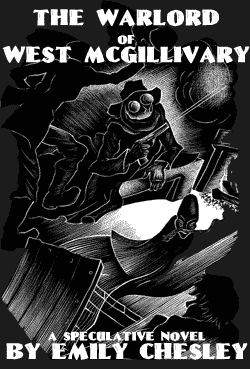| Emily's Biography | The Oeuvre | Flannigan Bio | The Inventions | ||
| Associated Figures | Literary Contest | The Frolics Store | About the Circle |
Emily's Oeuvre
|
|||||||||||
Emily's Oeuvre |
|||||||||||
| (in)Complete
Works Original Fiction & Poetry Novel Gallery Chesleyan Chestnuts |
 The
Warlord of West McGillivary The
Warlord of West McGillivary 1913, Bestiary Books by Emily Chesley Though far from her most successful novel, The Warlord of West McGillivary is one of her most interesting works, predicting the rise of totalitarianism and examining its effects on the individual. It also incorrectly predicts the importance of cruiseware. Emily wrote the book between March and May of 1912, en route to San Francisco aboard the SS Bugaroo. The Australian tramp steamer was famous in the South Pacific for its unconventional silhouette and nefarious owner, Master Bevridge P. Varnish, and both had an impact on the novel. (1) Emily boarded in Tasmania, shortly after visiting the South Pole with Roald Amundsen, leader of the Norwegian expedition. As she had done on the trip to the pole, she disguised herself as a man, though it was a fiction that the crew could see through easily, without heavy seal-skins to conceal her curvaceous buttocks. Nobody mentioned this, particularly Master Varnish, as Emily was good for the crew's morale. (2) As with her earlier works, The Warlord of West McGillivary is set in Southwestern Ontario; the main action begins in a little town called Lieury, and then moves to the wider world. The story has two threads: the main story follows Shelly Icymie, a "pleasure worker" in a dystopia called Britnor. Icymie is a sensitive woman who does not enjoy her work as much as scholars familiar with the Chesleyan oeuvre would assume. Indeed, she hates her position in this society (or rather, her variety of positions) servicing Britnor troops as they are at war, by turns, with Pacifica, Eurafric and Sinoria over the issue of which empire has the best holiday cruiseware. The other thread takes the reader back 40 years, and follows an un-named boy as he grows up in Lieury, terrorized by a domineering mother and abused by his insane aunt, who spends most of her time catching field mice and preserving them in mason jars. (3) By the middle of the story, it is clear that his un-named boy is going to grow into the Warlord – the "Fearless Father" of Britnor. While aboard the Bugaroo, Emily noted how Varnish terrorized his crew – played one party against the other – and generally maintained an iron control through the force of his personality and the dangers of the "water". At this time she was reading Jung’s "The Psychology of the Unconscious"; Jung's ideas of extroverted and introverted personalities clearly had an impact on her work. The Warlord of West McGillivary is an in-depth study of two such personalities, and extrapolates those ideas into a wider social realm. Britnor (and by implication, the other empires it is at war with) is a dangerously extroverted society. Instead of the sea as its constant outside danger, Britnor has war with the other empires. Scholars have noted the similarity in milieu between this book and George Orwell's 1984. (4) However, it is unlikely that Orwell ever read The Warlord of West McGillivary, as only 100 copies were printed, and most of them were immediately used as toilet paper when they were inadvertently shipped to France in 1914. (5) --"Scholarship" by The Squire
1) The Bugaroo had a large central stack, and two short, squat, somewhat rounded stacks on either side; this led the Polynesian natives of one of the Bugaroo's regular port-of-call's, Bigee Bigee, to giggle whenever it hove into sight. They nicknamed the craft: pelekeneckebulugaboaanoaa (roughly translated day as: the boat that has a pecker for a mast). Varnish was known throughout the South Seas for his strict discipline, as well as his penchant for water sports. [back] 2) Phringus Evans, a petty officer aboard the Bugaroo wrote in a letter to his brother: "I can put up with any number of the Captain's famous "shellackings" as long as Emily is on board. She has a way of putting a man at ease. (After standing him up, of course.)" [back] 3) This activity is actually a West McGillivary tradition known as 'bottletobbin' and interestingly, was practiced by the ancient Buverians of Bagatia Minor, as reported in 128 BC by the Roman general Lucius Marcellus Zippo in his excellent scroll: "Dilerium Buveria: Ars rodentia" (trans. "Those Mad Buverians: The Art of Mouse Collecting.") [back] 4) All except for Professor Mark S. H. Arpo, Fellow in Obvious Connections at UBS, who is extremely thick. [back] 5) It should be noted that they were not sent to the
Western Front, but to Madame Le Flatulance, resident of 13 Rue Liquimerde.
[back] |
|||
|
Emily's Bio
| The Oeuvre
| Flannigan Bio
| Inventions Join our mailing list or send us email. All written material, graphics, logo, and html coding Web Monkey: Mark A. Rayner |